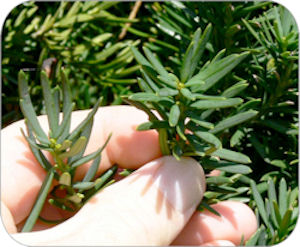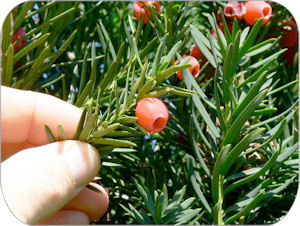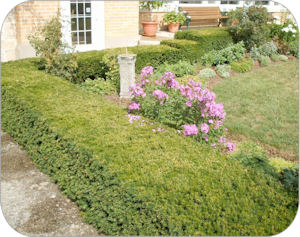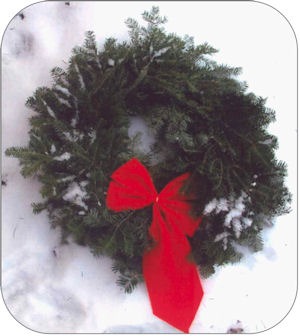Yew poisoning in horses and ruminants
Learn how to recognize the yew plant and signs of poisoning in horses and ruminants.
ISSN 1198-712X, Published October 2007
Introduction
The genus Taxus consists of three commonly grown ornamental shrubs — English yew, Canada yew and Japanese yew — and hybrids. The needles and seeds of all yews are highly poisonous to horses, cattle, sheep and goats (Figure 1), although the red, fleshy seed covering is not. Wild deer, moose and elk browse on yews as winter food and are not affected by the yew toxin. Humans, particularly children, are also susceptible to the toxins in these plants.
Yew species contain a number of toxic alkaloids, the most toxic of which are taxine A and B. They are collectively referred to as "taxine" and mainly affect the heart. Taxine inhibits normal sodium and calcium exchange across myocardial (heart muscle) cells, depressing electrical conduction across the heart and resulting in arrhythmias (abnormal heart rhythm)
Yews, fresh and dried, are toxic year round. Consumption of as little as 1-10 g/kg of body weight for ruminants and 0.5-2 g/kg for horses is lethal

Clinical signs
Sudden death, often within 2-3 hours of ingestion, is the most common observation with yew poisoning
Other causes of sudden death in horses and ruminants include (italics indicate the most susceptible species):
- bloat (ruminants)
- poison hemlock
- botulism
- ionophore toxicity (monensin — Rumensin, lasalocid — Bovatec) (horses)
- red maple leaf poisoning (horses)
- copper poisoning (sheep)
- clostridial diseases (ruminants)
- anthrax
- lightning strike
- intestinal accidents
Identifying yew evergreens
The native yew species include the Canada yew (Taxus canadensis), a shrub found in Eastern Canada, and the Western yew (Taxus brevifolia), a medium tree up to 20 m high found on the West Coast. Various yews are common as landscape ornamentals and include the English yew (Taxus baccata), a tree/shrub that can grow up to 25 m high, and the Japanese yew (Taxus cuspidata), a smaller shrub. All are poisonous to horses, livestock and humans.
Yews are evergreens with soft, flat, abruptly pointed, needle-like leaves that are 15-30 mm long. The upper surface is dark green with a lighter green underside. Leaves are arranged spirally or in a flat plane. Most cultivated varieties are compact, and the plants retain a dense character with age.
The twigs are flexible. When young, they are green, becoming greenish-brown or reddish-brown with age. The bark is thin and scaly and varies from dark, reddish-brown to purplish-brown.
Yew seeds are hard, dark brown/blue, nut-like in shape and about 8 mm in diameter. Seeds are set inside an attractive, red, fleshy fruit (aril) that can be found on the underside of recent twigs (Figure 2).

Yews range in height from shrub-size to medium-sized trees 25 m high. They can live for several hundred years. With age, the trunk can become twisted and fluted with an irregular-shaped canopy, often with multiple tops, especially in the absence of pruning.
Summary
Yews are planted for many landscape purposes (Figure 3). They can withstand trimming and shaping and are easily transplanted. They can tolerate urban pollution but not road salt. Never plant yew trees or shrubs near horse and/or livestock pastures or areas of the property where horses or other livestock can nibble while pastured, ridden or exercised, e.g., around the farmhouse. Remove any yews growing wild in, or adjacent to, horse and livestock pastures, or wooded pastures.

Evergreen branch clippings of yew are sometimes used to make Christmas ornaments, such as wreaths and hanging decorations (Figure 4). Never hang wreaths of yew on barn doors or on fence posts where horses, ponies or other livestock can reach them. Never discard yew ornaments or hedge clippings of yew onto manure or compost piles where they are accessible to horses, cattle, sheep and/or goats.

Resources
- Dirr MA. Manual of Woody Landscape Plants: Their Identification, Ornamental Characteristics, Culture, Propagation and Uses. 5th ed. Champaign, IL: Stipes Publishing, 1998.
- Farrar JL. Trees in Canada. Markham, Ontario: Fitzhenry & Whiteside Limited, 1995. ISBN 1-55041-199-3
- MacKillop E. Cornell University Poisonous Plants Information Database.
Footnotes
- footnote[1] Back to paragraph Knight AP, Walter RG. A Guide to Plant Poisoning of Animals in North America. Jackson, Wyoming: Teton New Media, 2001.
- footnote[2] Back to paragraph Munro DB. Canadian Poisonous Plants Information System.